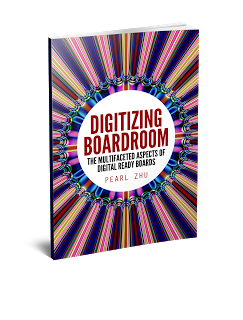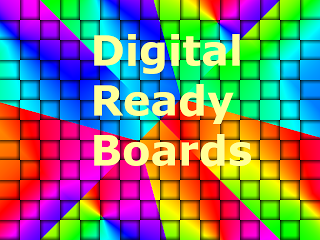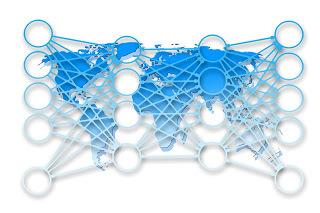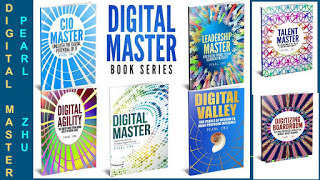Pearl Zhu's Blog, page 1298
September 12, 2016
Practice CIO Plus Leadership to Run IT with “Enlightenment”
 IT is moving up its maturity level from functioning to firm to delight. IT is neither luxury nor commodity, it's a competitive differentiator. With the new and disruptive technologies, CIOs need to change IT DNA from change inertia to change as a new normal; from a controller to an enabler, from inside-out to outside-in. No more dictating technology solutions, but having a better understanding of the business and transforming into a business partner to provide business and customer driven solutions.
IT is moving up its maturity level from functioning to firm to delight. IT is neither luxury nor commodity, it's a competitive differentiator. With the new and disruptive technologies, CIOs need to change IT DNA from change inertia to change as a new normal; from a controller to an enabler, from inside-out to outside-in. No more dictating technology solutions, but having a better understanding of the business and transforming into a business partner to provide business and customer driven solutions.
IT "enlightenment" comes when IT allows the business to do new things: IT is transforming from “controller” to “enabler,” leading through “pulling” than ‘pushing.’ When IT is only the mechanism for realizing a vision described by other C-level executives, it becomes a commodity. When CIOs become a plus role beyond an IT manager, but as a critical and integral member of the C-level, IT is becoming far more than simply keeping the lights on - but is transforming to significant business enablement, as a full business partner. IT must be willing to take the constructive criticism from customers, and turn the beating, lashing, and criticism into opportunities by demonstrating through the delivery of successful IT projects that not only benefit the business but gives customers a sense of personal satisfaction. To put simply, IT cannot simply create the potential for value, they must be engaged enough with the business (not just the technology that supports the business) to actively participate in value realization.
IT “enlightenment” comes when IT is no longer just dealing with technology challenges, but solving thorny business problems: It does not necessarily mean CIOs will solve every problem on their own. It’s about the ability to think analytically and synthetically to manage business solution via high-performance IT team; the ability to align the business requirement with the IT capacity, the strong business orientation to bring the benefits of IT to solve business issues. It means that CIOs are able to constantly and dynamically lead an IT structure that will seamlessly support the business and well ahead of the business requirement; the ability to interact with business on their processes and pain areas, the ability to bring out a technology driven solution, driving adoption of applications (going with change management, the most difficult piece). The cio-plus role is like the spinal cord for the organization, integrating various departments, to simplify and unify processes across functional boundaries, and often across the entire enterprise. This requires an unprecedented level of collaboration with the line managers and business units who own those processes.
 IT “enlightenment” comes when IT is both winning heart, mind and profit to improve the top line business growth: CIOs have to get the transformation agenda right and have access to both external and internal resources to achieve the desired ROI. But without your peers' collaborating, the work will become much harder, so get as many people pulling in the same direction. The digital CIO should focus on the information content and context; how that information can be tapped from the underlying data and be utilized to turn it into valuable strategic insight, to both enchant customers and delight employees, focus on how the information and insight can be penetrated through the business and be actively used in grasping business opportunities, managing business processes and shaping the business capabilities to execute business strategy solidly.
IT “enlightenment” comes when IT is both winning heart, mind and profit to improve the top line business growth: CIOs have to get the transformation agenda right and have access to both external and internal resources to achieve the desired ROI. But without your peers' collaborating, the work will become much harder, so get as many people pulling in the same direction. The digital CIO should focus on the information content and context; how that information can be tapped from the underlying data and be utilized to turn it into valuable strategic insight, to both enchant customers and delight employees, focus on how the information and insight can be penetrated through the business and be actively used in grasping business opportunities, managing business processes and shaping the business capabilities to execute business strategy solidly.
Today, the CIO is not just managing IT to keep the lights on, but managing the information to ensure the right people getting the right information at the right time to make the right decision, to enable enterprise growth, to become nimble and gain the competitive edge, to harness innovation catalyzed by IT and lead to business transformation. In order to drastically change IT landscape, you must have passion and drive at the core along with daily grinding. In fact, CIO is a leadership plus role to run digital IT with enlightenment.
Follow us at: @Pearl_Zhu
Published on September 12, 2016 22:08
September 11, 2016
The Monthly Insight of the Board Room: “Digitizing Boardroom” Book Summary Sep, 2016
 Modern corporate boards play significant roles in guiding businesses toward the right direction and achieve expected business results. Due to the “VUCA” characteristics -Complexity, Uncertainty, Ambiguity and Velocity of the Digital Era, the directorship in any organization must have the agility to adapt to changes, and build abilities to advise, inspire and motivate a group of people toward accomplishing shared visions and goals.
Modern corporate boards play significant roles in guiding businesses toward the right direction and achieve expected business results. Due to the “VUCA” characteristics -Complexity, Uncertainty, Ambiguity and Velocity of the Digital Era, the directorship in any organization must have the agility to adapt to changes, and build abilities to advise, inspire and motivate a group of people toward accomplishing shared visions and goals.
“Digitizing Boardroom” Book SummaryIntroduction: The main purpose of the book “ Digitizing Boardrooms -The Multifaceted Aspects of Digital Ready Board ” is to-Envision the future of directorship with twenty-three digital boardroom themes.-Oversee business strategies with digital fluidity, digital mindset, and contextual intelligence.-Make policies and effective decisions on transforming boards from conformance to performance driven.-Rejuvenate boardrooms via participating in both innovation management and management innovation.-Highlight the importance of building IT friendly and technology-savvy digital boards.-Develop the best and next governance practices towards achieving corporate excellence.-Advocate digital fitness and innovate people management to become “Talent Master.”-Set digital culture tones, and fine-tune processes to make boards highly effective and highly mature.
Chapter 1 The Digital Themes of Boardrooms: With many organizations and the society as a whole reach the inflection point of digital transformation, the modern corporate board as one of the top governance bodies plays a crucial role in setting business leadership tones and driving the organization’s digital transformation
Chapter 2 A Strategic Board: The board plays a critical role in overseeing business strategies, it is important to keep the board strategically focused. Also, the board as the top leadership team advises business strategies, it doesn’t always mean the Board itself is being strategic enough. The board represents the ownership and they really cannot do a good job if they don't have the knowledge to challenge and set the broad strategic goals. ?
Chapter 3 A Performance-driven Board: Corporate Performance Management (CPM) has many descriptors and understandings globally. However, there is universal agreement that best practice performance management frameworks should inform the board, management, staff and key stakeholders on the performance of the organization in delivering services or programs efficiently, in achieving organizational outcomes effectively and in making the progress towards achieving sustainability effortlessly.
Chapter 4 An Innovative Board: The Boards of Directors are interactive change agents that represent the organization, stockholders, and senior management. No longer are boards sitting in a room and just voting on various policies. It is one of the requirements of the Board members to participate, or even lead, in constantly suggesting areas of innovation since their vistas are likely to be wider, and also because the Board should be highly accountable for strategies for the future of the company. The board plays a crucial role in management innovation as well.
Chapter 5 An IT Friendly Board: Information is the lifeblood and one of the most invaluable assets in digital businesses today, technology is the disruptive force behind the digital transformation. IT is the business catalyst. More often than not, IT directly impacts on strategy shaping. Therefore, Digital BoDs need to become more information savvy and technology smart.
Chapter 6 A “Governance Champion” Board: Business governance is the other important responsibility of the corporate board. Governance is a sophisticated process that if well executed, will lead to better decisions. It will allow not only to protect the existing value but also to create new value for its shareholders.
Chapter 7 A “Talent Master” Board: People are always the most invaluable asset in businesses. Digitalization and globalization have a huge impact in the business world, and talent has become the defining theme of this new digital paradigm. “Hiring the right person for the right position at the right time,” is the mantra of many forward-thinking organizations. However, very few organizations have well-crafted people or human capital strategy as an integral element in their business strategy. The question is: The Board as a top leadership team to oversee strategy and innovate people management, how can you set good policies to value people in multidimensional ways?
 Chapter 8: A Culture-Savvy Board: Many think boards do not pay enough attention to the culture within the company, since culture or subcultures can undermine strategy, they certainly should be concerned and seek assurance that the culture is aligned with the strategy and the values that form the foundation of the culture are aligned with the expectations of customers. The “Future of CIO” Blog has reached 1.5 million page views with 3100+ blog posting in 59+ different categories of leadership, management, strategy, digitalization, change/talent, etc. The content richness is not for its own sake, but to convey the vision and share the wisdom. Blogging is not about writing, but about thinking; it’s not just about WHAT to say, but about WHY to say, and HOW to say it. It reflects the color and shade of your thought patterns, and it indicates the peaks and curves of your thinking waves. Unlike pure entertainment, quality and professional content takes time for digesting, contemplation and engaging, and therefore, it takes time to attract the "hungry minds" and the "deep souls." It’s the journey to amplify your voice, deepen your digital footprints, and match your way for human progression.
Chapter 8: A Culture-Savvy Board: Many think boards do not pay enough attention to the culture within the company, since culture or subcultures can undermine strategy, they certainly should be concerned and seek assurance that the culture is aligned with the strategy and the values that form the foundation of the culture are aligned with the expectations of customers. The “Future of CIO” Blog has reached 1.5 million page views with 3100+ blog posting in 59+ different categories of leadership, management, strategy, digitalization, change/talent, etc. The content richness is not for its own sake, but to convey the vision and share the wisdom. Blogging is not about writing, but about thinking; it’s not just about WHAT to say, but about WHY to say, and HOW to say it. It reflects the color and shade of your thought patterns, and it indicates the peaks and curves of your thinking waves. Unlike pure entertainment, quality and professional content takes time for digesting, contemplation and engaging, and therefore, it takes time to attract the "hungry minds" and the "deep souls." It’s the journey to amplify your voice, deepen your digital footprints, and match your way for human progression.
"Digitizing Boardroom" Book Quote Collection 3"Digitizing Boardroom" Book Quote Collection 2"Digitizing Boardroom" Book Quote Collection 1"Digitizing Boardroom" Book Chapter 8 A Culture Savvy Board Introduction"Digitizing Boardroom" Book Chapter 7 A "Talent Master" Board Introduction"Digitizing Boardroom" Book Chapter 6 A "Governance Champion" Board Introduction"Digitizing Boardroom" Book Chapter 5 An IT-Friendly Board Introduction "Digitizing Boardroom" Book Chapter 4 An Innovative Board Introduction"Digitizing Boardroom" Book Chapter 3 A Performance-driven Board Introduction"Digitizing Boardroom" Book Chapter 2 A Strategic Board Introduction"Digitizing Boardroom" Book Chapter 1 23 Themes of Digital Boardrooms Introduction"Digitizing Boardroom" Book Preview"Digitizing Boardroom" Book Introduction, Slideshare Presentation
Follow us at: @Pearl_Zhu
Published on September 11, 2016 22:18
Making a Leap in IT Digital Transformation
 More and more IT organizations are transforming from back end internal support function into front office revenue generators, from reactive order taker to proactive changing organization; from doing more with less to doing more with innovation, and from IT-business alignment to IT-business engagement. They help the company achieve its business objectives in any way possible. It is the right timing for IT to make a leap in digital transformation.
More and more IT organizations are transforming from back end internal support function into front office revenue generators, from reactive order taker to proactive changing organization; from doing more with less to doing more with innovation, and from IT-business alignment to IT-business engagement. They help the company achieve its business objectives in any way possible. It is the right timing for IT to make a leap in digital transformation.
Revenue Growth: IT leadership have to be an integral part of top business leadership in driving business growth. It is about top-line business growth by maximizing ROI to add up overall business value in the second dimension. IT leaders can do so by integrating technology with strategy. Information executives have to be fully aligned with the business executives in articulating business strategy. IT leaders need to encourage their teams to spend more time with leaders on the business side as well as directly with customers. These engagements are leading IT to be much more proactive in proposing - as opposed to responding to - ideas for new ways to improve customer service or actually create new customer value and revenue. When maintaining a clear and efficient bottom line for “keeping the lights on,” with enough forward thinking to 'plan in' growth, and this dimension allows the organization to use technology to pour more on the top line.
Define, realize and measure multidimensional-IT value proposition: The business paradigm is shifting from the industrial era to an information/digital era, technology plays a pivotal role in such transformation, and therefore, IT value needs to reflect such shift. Digital is the age of information abundance. Information value and intellectual capital can not be underestimated. IT value-based management also needs to be driven by concepts like collaborative value or collective advantage and multi-layer ROIs. Generally speaking, IT value is demonstrated through the rate of productivity increases, the rate of new product development, the rate of market share gains, the rate of customer approval and satisfaction gains, the rate of sales gains, etc. The true value is created at the intersection of many disciplines. Different companies may have different definitions of IT value. In order to show value, first, all parties need to agree on the common value proposition, then, you need to be able to measure the right things and measure them in the right way.
 IT manageability: IT is about using technology to lower costs, improve operations, and increase revenue. The Focus of digital IT needs to provide business capabilities, not just services or solutions. Effective IT management means understanding every island of operation and every workflow process. It is through this comprehensive understanding that a CIO would be able to identify true cost savings, workflow optimizations, and additional revenue opportunities. IT is not a function that can be handled only inside the IT department or by IT managers, it takes collective effort and cross-functional collaboration to run a holistic IT and improve IT overall manageability. Business expects IT to become new capability enablers at higher-change organizations that compete on product/service differentiation. There are best practices and next practices to create and reinforce IT brand, to advocate innovation and improve IT agility.
IT manageability: IT is about using technology to lower costs, improve operations, and increase revenue. The Focus of digital IT needs to provide business capabilities, not just services or solutions. Effective IT management means understanding every island of operation and every workflow process. It is through this comprehensive understanding that a CIO would be able to identify true cost savings, workflow optimizations, and additional revenue opportunities. IT is not a function that can be handled only inside the IT department or by IT managers, it takes collective effort and cross-functional collaboration to run a holistic IT and improve IT overall manageability. Business expects IT to become new capability enablers at higher-change organizations that compete on product/service differentiation. There are best practices and next practices to create and reinforce IT brand, to advocate innovation and improve IT agility.
Making a leap in digital transformation is not an overnight sensation, but take a systematic approach with stepwise practices. A digital transformation is achieved via dynamic Strategy-Execution-Change life cycle management: Though it is not all linear steps, but clear vision and well-defined business goals, the effective decision-making, and performance measurement are all important success factors in leapingfrog digital transformation.
Follow us at: @Pearl_Zhu
Published on September 11, 2016 22:14
September 10, 2016
Raising the Profile of Digital CIOs
 Contemporary digital CIOs wear multiple hats, play different roles with multiple personas. There is a distinct difference between a great CIO and an average CIO in terms of identifying and implementing competitive advantages and being a great leader. What are modern CIOs’ digital profile, and how they improve leadership effectiveness and shift their role from transactional managers to transformational leaders?
Contemporary digital CIOs wear multiple hats, play different roles with multiple personas. There is a distinct difference between a great CIO and an average CIO in terms of identifying and implementing competitive advantages and being a great leader. What are modern CIOs’ digital profile, and how they improve leadership effectiveness and shift their role from transactional managers to transformational leaders?
Great CIOs are technological visionaries: A great CIO has a clear technological vision of IT strategy as an integral element of the business strategy based on the existing and the future business needs, forecasting and adapting the business so it continues to thrive. Understanding business needs is the key success factor for the CIO because designing and implementing IT solutions that accommodate existing and future business and technology changes is a real challenge. Great CIOs should be able to translate the business needs from the business units into technological goals and long-term strategies that the IT teams can then provide solutions for. They needs to understand ROI -return on investment, depreciation, the total cost of ownership, the time value of money, and have a good grasp of how each business unit’s critical processes work, and how to improve the business performance or create new opportunities, not just implementing the state of the art technology from IT perspective, but drive business growth.
Great CIOs are essential business advisors: CIOs bridges the gap between these two domains - business and technology. A great CIO needs to provide expert advice and recommendations to the rest of the executive leadership. The honest justification for a recommendation to adopt new technologies or not as requested by executive leadership requires that the CIO has built a level of trust with the executive team first. Great CIOs need to be insightful communicators as well, not only convey the vision but also be able to inspire the team, executive peers to perceive the future of IT, the future of business and the future of leadership as well, to engage with the business and provide measurable results. CIOs must understand the business and the role IT plays in it, knowing IT capabilities well helps him/her to better perform the job. By understanding the business and adding value beyond just IT, such quality makes a great CIO. Great CIOs are customer champions who always set priority to run IT as a business enabler to build solid business capabilities, in order to optimize customer experience and delight end customers as well.
 A great CIO also needs to be a great mentor: The benefit of coaching style is to develop the employees in terms to make them real high performers. The coach/mentor style CIOs can show the team how to explore their own natural skill sets, talents, and strong sides, take into account their own objectives in line with working needs. CIO could also try to be the technology mentor for the organization’s executives, to clarify and demonstrate the business values of IT, the results of this effort is depending on the culture of the organization. In order to be the good mentor, CIOs have to become a continuous learner. Simply being an active member in forums and other collaborative networks with an ear and an eye to innovations and business benefits from learning and discussions. If CIOs exemplify learning agility, and also encourage those they guide to seek ongoing experience and knowledge, then you will certainly grow a team that can drive your organization to great heights, reduced costs and leaps in innovation and productivity etc. Most importantly, this leads to a great environment to work in and to build future CIOs that will also remain informed and prepared to share their learning.
A great CIO also needs to be a great mentor: The benefit of coaching style is to develop the employees in terms to make them real high performers. The coach/mentor style CIOs can show the team how to explore their own natural skill sets, talents, and strong sides, take into account their own objectives in line with working needs. CIO could also try to be the technology mentor for the organization’s executives, to clarify and demonstrate the business values of IT, the results of this effort is depending on the culture of the organization. In order to be the good mentor, CIOs have to become a continuous learner. Simply being an active member in forums and other collaborative networks with an ear and an eye to innovations and business benefits from learning and discussions. If CIOs exemplify learning agility, and also encourage those they guide to seek ongoing experience and knowledge, then you will certainly grow a team that can drive your organization to great heights, reduced costs and leaps in innovation and productivity etc. Most importantly, this leads to a great environment to work in and to build future CIOs that will also remain informed and prepared to share their learning.
Great CIOs are multi-dimensional thinkers and versatile leaders. It's about having the right blend of leadership skills, business knowledge and technical knowledge that makes the digital IT leaders. Technical knowledge of leadership is just one of the tools in your toolbox, and you need to keep them all sharp to work effectively. How you sharpen your tools is a personal choice. This is an issue of a mix of leadership and hands-on approach, a mix of macro and micro perspective, and a mix of inspiring innovation and setting the standard. Great CIOs are great leaders.
Follow us at: @Pearl_Zhu
Published on September 10, 2016 23:40
Building People -Centric Changeability to Fuel Digital Transformation
One of the good reasons for the change is to keep the organization fit, and a fitting business has better changeability and higher agility as well.
 Digital means change with increasing velocity and speed. Change is no longer just a one-time business initiative, but an ongoing business capability. Change capability is one of the strategic capabilities which underpin successful execution. It moves the organization from efficiency to agility. However, no change is for its own sake, there's always a clear business purpose behind it, and people are the core to changes, by overcoming these challenges, Change Management can become an enjoyable voyage to discover the new landscape of business and fuel digital transformation.
Digital means change with increasing velocity and speed. Change is no longer just a one-time business initiative, but an ongoing business capability. Change capability is one of the strategic capabilities which underpin successful execution. It moves the organization from efficiency to agility. However, no change is for its own sake, there's always a clear business purpose behind it, and people are the core to changes, by overcoming these challenges, Change Management can become an enjoyable voyage to discover the new landscape of business and fuel digital transformation.
People-centric Change capability: There is no change for its own sake, there's always a clear business purpose behind it, and people are the core of changes. Developing change capability in those who'll help drive and deliver the change, consider also the capability or ability of those impacted by the change to handle its impacts; their resilience will be massively increased if they are involved, included and educated as to what they should expect. Building people-centric changeability is prerequisite for dynamic digital strategy execution. Digital transformation is the leapfrogging scenario with accumulated steps of changes. Many people across the organization are either directly involved in contributing to the change effort, or they have the opportunity to participate and choose to hold back but know they had the chance to contribute, or, at least, they regularly hear about the key change effort, the design, and progress made even if they have no direct involvement at all. People-centric change management capability is built via the top executive generous sponsorship, the middle-management dedicated execution, and the bottom line fully supports. The key trait is credibility at every level of organizations. It is imperative to find a progressive executive sponsor, but you must also find other like-minded, well-respected individuals throughout the organization, to take accountability in the change project or any transformation effort. They will serve the organization with more energy and determination.
Digital Fitness: One of the good reasons for the change is to keep the organization fit, and a fitting business has better changeability and higher agility as well. Organizational fit starts with mind fit, it means people have growth mind to adapt to change. The organizational fit is the good balance of the fitting attitude and “misfit” thinking. Organizational fit from conventional lenses makes relationships easy and perpetuates the status quo, so if companies are satisfied with where they are and going then they should pay attention to fit. If things need to change then they need to quit hiring clones. Organizational fit means more about value adding or behavioral norms. And people need to be intentional about how they enter the role, focusing on understanding and bringing wisdom to the workplace. The failure to do this is one of the biggest causes of derailment -- and creator of the perception of poor-fit. The fit is also not equal to be compliant only, the ‘group think’ is one of the most devastating to team performance and certainly to a team’s ability to innovate. Organizational fit, manifested in accepted and expected behavior, has a way of neutralizing difference, improve its effectiveness, efficiency, and agility.
 Simplicity: Change Management should always follow “simplicity” principle; with simplicity, the goal of Change Management and digitization is to add clarity and purpose. Simplicity means or is related to too many things such as manageability, availability, scalability, flexibility, reliability, robustness, sensitivity, comprehensiveness, speed, responsiveness, etc. One of the decent goals for change is to eliminate redundancy, get rid of complication, and remove unwanted complexity assumptions & dependencies, more clearly reveals the intentions of the business and its purpose. Simplicity is the characteristic of change management to looking for what is common for maximum, reuse. And simplicity needs to be the building blocks of the digital business.
Simplicity: Change Management should always follow “simplicity” principle; with simplicity, the goal of Change Management and digitization is to add clarity and purpose. Simplicity means or is related to too many things such as manageability, availability, scalability, flexibility, reliability, robustness, sensitivity, comprehensiveness, speed, responsiveness, etc. One of the decent goals for change is to eliminate redundancy, get rid of complication, and remove unwanted complexity assumptions & dependencies, more clearly reveals the intentions of the business and its purpose. Simplicity is the characteristic of change management to looking for what is common for maximum, reuse. And simplicity needs to be the building blocks of the digital business.
"Change management" is the overarching umbrella, that encompasses extensive planning, outreach, communications, discovery of concerns / objections / potential points of failure, addressing fears and resistance, developing a shared vision, communicating valid and compelling reasons for cooperation, recognizing sacrifice and incremental success, measuring outcomes in a shared and mutually understood and agreed upon fashion, being able to declare an end-point and successful conclusion. People-centric change capability is different from the mere sum of individual abilities and skills of its members; processes underpin business capabilities; and culture nurtures capability coherence. Change capability of the business is built via the alignment of people, process, and technology, it refers to modification and internalization of new values, behaviors, and culture when the need for the significant digital shift is identified. It’s about what we do as a company, how we do it, it’s collective capabilities to ensure organization as a whole can achieve maximum values and reach the zenith of the high performance.
Follow us at: @Pearl_Zhu
 Digital means change with increasing velocity and speed. Change is no longer just a one-time business initiative, but an ongoing business capability. Change capability is one of the strategic capabilities which underpin successful execution. It moves the organization from efficiency to agility. However, no change is for its own sake, there's always a clear business purpose behind it, and people are the core to changes, by overcoming these challenges, Change Management can become an enjoyable voyage to discover the new landscape of business and fuel digital transformation.
Digital means change with increasing velocity and speed. Change is no longer just a one-time business initiative, but an ongoing business capability. Change capability is one of the strategic capabilities which underpin successful execution. It moves the organization from efficiency to agility. However, no change is for its own sake, there's always a clear business purpose behind it, and people are the core to changes, by overcoming these challenges, Change Management can become an enjoyable voyage to discover the new landscape of business and fuel digital transformation.
People-centric Change capability: There is no change for its own sake, there's always a clear business purpose behind it, and people are the core of changes. Developing change capability in those who'll help drive and deliver the change, consider also the capability or ability of those impacted by the change to handle its impacts; their resilience will be massively increased if they are involved, included and educated as to what they should expect. Building people-centric changeability is prerequisite for dynamic digital strategy execution. Digital transformation is the leapfrogging scenario with accumulated steps of changes. Many people across the organization are either directly involved in contributing to the change effort, or they have the opportunity to participate and choose to hold back but know they had the chance to contribute, or, at least, they regularly hear about the key change effort, the design, and progress made even if they have no direct involvement at all. People-centric change management capability is built via the top executive generous sponsorship, the middle-management dedicated execution, and the bottom line fully supports. The key trait is credibility at every level of organizations. It is imperative to find a progressive executive sponsor, but you must also find other like-minded, well-respected individuals throughout the organization, to take accountability in the change project or any transformation effort. They will serve the organization with more energy and determination.
Digital Fitness: One of the good reasons for the change is to keep the organization fit, and a fitting business has better changeability and higher agility as well. Organizational fit starts with mind fit, it means people have growth mind to adapt to change. The organizational fit is the good balance of the fitting attitude and “misfit” thinking. Organizational fit from conventional lenses makes relationships easy and perpetuates the status quo, so if companies are satisfied with where they are and going then they should pay attention to fit. If things need to change then they need to quit hiring clones. Organizational fit means more about value adding or behavioral norms. And people need to be intentional about how they enter the role, focusing on understanding and bringing wisdom to the workplace. The failure to do this is one of the biggest causes of derailment -- and creator of the perception of poor-fit. The fit is also not equal to be compliant only, the ‘group think’ is one of the most devastating to team performance and certainly to a team’s ability to innovate. Organizational fit, manifested in accepted and expected behavior, has a way of neutralizing difference, improve its effectiveness, efficiency, and agility.
 Simplicity: Change Management should always follow “simplicity” principle; with simplicity, the goal of Change Management and digitization is to add clarity and purpose. Simplicity means or is related to too many things such as manageability, availability, scalability, flexibility, reliability, robustness, sensitivity, comprehensiveness, speed, responsiveness, etc. One of the decent goals for change is to eliminate redundancy, get rid of complication, and remove unwanted complexity assumptions & dependencies, more clearly reveals the intentions of the business and its purpose. Simplicity is the characteristic of change management to looking for what is common for maximum, reuse. And simplicity needs to be the building blocks of the digital business.
Simplicity: Change Management should always follow “simplicity” principle; with simplicity, the goal of Change Management and digitization is to add clarity and purpose. Simplicity means or is related to too many things such as manageability, availability, scalability, flexibility, reliability, robustness, sensitivity, comprehensiveness, speed, responsiveness, etc. One of the decent goals for change is to eliminate redundancy, get rid of complication, and remove unwanted complexity assumptions & dependencies, more clearly reveals the intentions of the business and its purpose. Simplicity is the characteristic of change management to looking for what is common for maximum, reuse. And simplicity needs to be the building blocks of the digital business.
"Change management" is the overarching umbrella, that encompasses extensive planning, outreach, communications, discovery of concerns / objections / potential points of failure, addressing fears and resistance, developing a shared vision, communicating valid and compelling reasons for cooperation, recognizing sacrifice and incremental success, measuring outcomes in a shared and mutually understood and agreed upon fashion, being able to declare an end-point and successful conclusion. People-centric change capability is different from the mere sum of individual abilities and skills of its members; processes underpin business capabilities; and culture nurtures capability coherence. Change capability of the business is built via the alignment of people, process, and technology, it refers to modification and internalization of new values, behaviors, and culture when the need for the significant digital shift is identified. It’s about what we do as a company, how we do it, it’s collective capabilities to ensure organization as a whole can achieve maximum values and reach the zenith of the high performance.
Follow us at: @Pearl_Zhu
Published on September 10, 2016 23:33
September 9, 2016
The Monthly “Digital Master” Book Tuning: Running a High-Mature Digital Organization Sep. 2016
 Digital Master refers to those high-performing, high innovative and high-mature (less than 15%) digital organizations; they have both clear digital vision and well-crafted digital strategy; they are courageous to be in the vanguard of digital transformation with a quantum lead. But they also proactively develop more advanced and unique digital capabilities step-by-step and build a digital premium into their very foundation of business, such as digital thinking, culture, agility, intelligence, and structure, and they achieve high performing results through strong digital governance discipline and reach its zenith as the digital world continues to expand and diversify. At the individual level, Digital Masters are those cross-generational digital professionals who are equipped with the advanced digital minds and build a unique set of digital capabilities, climb to the top of Maslow’s Pyramid 2.0.
Digital Master refers to those high-performing, high innovative and high-mature (less than 15%) digital organizations; they have both clear digital vision and well-crafted digital strategy; they are courageous to be in the vanguard of digital transformation with a quantum lead. But they also proactively develop more advanced and unique digital capabilities step-by-step and build a digital premium into their very foundation of business, such as digital thinking, culture, agility, intelligence, and structure, and they achieve high performing results through strong digital governance discipline and reach its zenith as the digital world continues to expand and diversify. At the individual level, Digital Masters are those cross-generational digital professionals who are equipped with the advanced digital minds and build a unique set of digital capabilities, climb to the top of Maslow’s Pyramid 2.0.Running a High Mature Digital Organization Sep. 2016Three “DE” Effort in Digitizing the Organization Digital makes a significant impact on every aspect of the business from people, process to technology, both horizontally and vertically. Businesses become hyperconnected and interdependent and get involving in the dynamic digital ecosystem all the time. Given the power of the cloud, social, mobile and analytics digital technologies to fuel business innovation, capability orchestration, and employee collaboration, digital becomes the very fabric of high performing business. However, the journey of digital transformation is a thorny journey, not a flat street. You have to remove the roadblocks and eliminate the barriers all the time. Here are three “DE” effort to shift from “doing Digital” -applying digital technologies to “Being Digital” - Running a high mature digital organization.
Three Forces to Drive Digital Transformation: Digital transformation or Digital shift means change. It represents the next stage of business maturity which will improve how the enterprise works and interacts with its ecosystem, with the customer at the center of its focus, and innovation as its major theme. More specifically, what are are those visible and invisible forces to drive changes, and how to make such a large-scale transformation go more smoothly?
 IT Transformation as an Integral Part of Digital Transformation: Transformation seeks to change. The word "transformation" in itself means change and change for the better, the new ways and methods of doing things, new structures, new relationships, new capability, etc. Organizations large or small are on the journey of digital transformation, how to leverage information to capture business insight, and how to apply the latest technologies for improving business efficiency. How to run IT as a changing organization for catalyzing business transformation.
IT Transformation as an Integral Part of Digital Transformation: Transformation seeks to change. The word "transformation" in itself means change and change for the better, the new ways and methods of doing things, new structures, new relationships, new capability, etc. Organizations large or small are on the journey of digital transformation, how to leverage information to capture business insight, and how to apply the latest technologies for improving business efficiency. How to run IT as a changing organization for catalyzing business transformation.Three Portmanteau Hybrid Words to Envision a Digital Organization: Organizations large or small are on the journey to digital transformation, it is not an overnight phenomenon, but a well-planning strategy with the step-wise approach. There are physical buildings and virtual, always-on working environment; there are next innovation practices and “always do things like this” best practices; there’s abundance of information but still the scarcity of insight. It is the hybrid business world full of options. Digital is the age of alternatives, here are three portmanteau hybrid words to convey the management principles in running a digital organization?
 Making a Leap in Digital Transformation via Mixing Hard & Soft Elements Right: With the digital paradigm shift, forward-looking organizations are reimagining how to run and grow a dynamic or a "liquid" digital organization via both "hard push," and "soft pull." Hence, business managements need to make the proper adjustment as well to run an organic business with “living cells,” not just the mechanic firm composed of “hard nuts and knots.” Digital organizations as a whole are agile, flexible, dynamic and innovative. So how to make a leap in Digital Transformation via mixing hard & soft element right, and how to run, grow and transform your business effortlessly.
“Digital Master”
is the series of guidebooks (5+ books) to perceive the multi-faceted impact digital is making to the business & society, help forward-thinking organizations navigate through the journey in a systematic way, and avoid “rogue digital.” It perceives the emergent trends of digital leadership, advises on how to run a digital IT to unleash its full potential and improve agility. It also instructs digital workforce on how to shape game-changing digital mindset and build the right set of digital capabilities to compete for the future.
Making a Leap in Digital Transformation via Mixing Hard & Soft Elements Right: With the digital paradigm shift, forward-looking organizations are reimagining how to run and grow a dynamic or a "liquid" digital organization via both "hard push," and "soft pull." Hence, business managements need to make the proper adjustment as well to run an organic business with “living cells,” not just the mechanic firm composed of “hard nuts and knots.” Digital organizations as a whole are agile, flexible, dynamic and innovative. So how to make a leap in Digital Transformation via mixing hard & soft element right, and how to run, grow and transform your business effortlessly.
“Digital Master”
is the series of guidebooks (5+ books) to perceive the multi-faceted impact digital is making to the business & society, help forward-thinking organizations navigate through the journey in a systematic way, and avoid “rogue digital.” It perceives the emergent trends of digital leadership, advises on how to run a digital IT to unleash its full potential and improve agility. It also instructs digital workforce on how to shape game-changing digital mindset and build the right set of digital capabilities to compete for the future.The “Future of CIO” Blog has reached 1.5 million page views with about #3100th blog posting in 59+ different categories of leadership, management, strategy, digitalization, change/talent, etc. The content richness is not for its own sake, but to convey the vision and share the wisdom. Blogging is not about writing, but about thinking and innovating the new ideas; it’s not just about WHAT to say, but about WHY to say, and HOW to say it. It reflects the color and shade of your thought patterns, and it indicates the peaks and curves of your thinking waves. Unlike pure entertainment, quality and professional content takes time for digesting, contemplation and engaging, and therefore, it takes the time to attract the "hungry minds" and the "deep souls." It’s the journey to amplify diverse voices and deepen digital footprints, and it's the way to harness your innovative spirit.
Follow us at: @Pearl_Zhu
Published on September 09, 2016 23:24
Three insight for Talent Management Innovation
 Generally speaking, a professional is an individual with the expertise of some specific area, who earns his or her livings from that expertise. A digital knowledge professional is someone for whom knowledge is the main input for work, as opposed to another worker who obviously uses his/her brain, but depends more on expertise in using a particular tool or set of tools. It is the ability to transform which exists to which is new, that differentiate the digital knowledge worker from industrial knowledge workers. However, most organizations still apply the same set of talent management best practices developed decades ago to manage today’s digital workforce, mainly based on quantitative measurement, but lack qualitative judgment. No wonder there are talent gaps across industries, and there is very low percentage of employee engagement rate. The point is how to gain an in-depth understanding about today’s cross-generational and cross-cultural digital professionals, and how to build a creative workplace and high-performing digital workforce via innovating talent management and fine tuning performance management? Digital knowledge workforce has high innovation potential: Today’s digital professionals are innovative workers, hard workers, knowledge workers and intelligent workers, who are exploring, innovating and evolving bringing new digital paradigms. After all, we all find new ways to make our work "easier," more rewarding, better for ourselves or our customers/clients and for our society. Everyone displays innovation at some stage, some more often than others, some make more impact than others. It is the manager's/leader's role to encourage and nurture those who display these characteristics. -Individuals that have the intrinsic ability to think outside the box, and it is important to update talent management practices and performance measurement to encourage creativity and inspire learning, exploring and innovating
Generally speaking, a professional is an individual with the expertise of some specific area, who earns his or her livings from that expertise. A digital knowledge professional is someone for whom knowledge is the main input for work, as opposed to another worker who obviously uses his/her brain, but depends more on expertise in using a particular tool or set of tools. It is the ability to transform which exists to which is new, that differentiate the digital knowledge worker from industrial knowledge workers. However, most organizations still apply the same set of talent management best practices developed decades ago to manage today’s digital workforce, mainly based on quantitative measurement, but lack qualitative judgment. No wonder there are talent gaps across industries, and there is very low percentage of employee engagement rate. The point is how to gain an in-depth understanding about today’s cross-generational and cross-cultural digital professionals, and how to build a creative workplace and high-performing digital workforce via innovating talent management and fine tuning performance management? Digital knowledge workforce has high innovation potential: Today’s digital professionals are innovative workers, hard workers, knowledge workers and intelligent workers, who are exploring, innovating and evolving bringing new digital paradigms. After all, we all find new ways to make our work "easier," more rewarding, better for ourselves or our customers/clients and for our society. Everyone displays innovation at some stage, some more often than others, some make more impact than others. It is the manager's/leader's role to encourage and nurture those who display these characteristics. -Individuals that have the intrinsic ability to think outside the box, and it is important to update talent management practices and performance measurement to encourage creativity and inspire learning, exploring and innovating
Collective necessity vs. Collective Uniqueness: The staff’s collective competitive necessity will keep the business light on, assess talent with a set of skills which are necessary to do daily tasks bring both quantified and qualified result; this is traditional competency model based on. While, their collective uniqueness can help grow and even transform the organization. The management need pay more attention to those shining spots: Who can bring unique POVs, who can discover better way to solve problems, who takes extra miles to delight customers; who can think independently and challenge conventional wisdom, who is just unconventionally different, who is positive influencers for business culture? And who are those transformers to push the business up to higher maturity? For long-term business growth, organizations should recruit correct mindset, ability to learn and grow. Performance management systems and processes should gradually moving away from a static, unidirectional, and time-bound avatar to a more dynamic, continuous, and interactive state. Improved transparency, goal tracking, real-time feedback, and enterprise-wide acknowledgment/ recognition of achievements are some of the key drivers, which result in the adoption of digital and social performance management systems.
 Digital is the age of people: “SELF” is not just about "ME," but about authenticity via self-awareness, self motivation and self assessment: Digital business encourage autonomy, discovery and mastery, and help talent people climb up the Maslow’s pyramid. From performance management perspective, it is important for employees to do self-reflection, self-assessment, and self-improvement to discover "Who they are," via leveraging both thinking performance and action performance. Thinking Performance can make the assessment on employees’ vision, cognition, creativity, and leadership potential. Such a due performance assessment allows the employee to feel they are important and the organization is committed to their development whatever that may be. It can drive both employees and supervisors thoughts in the process. It is not a management check in the box. It is required developmental conversations and plans that are conducted with valued team members. The whole concept is obviously more involved than just evaluating quantitatively.
Digital is the age of people: “SELF” is not just about "ME," but about authenticity via self-awareness, self motivation and self assessment: Digital business encourage autonomy, discovery and mastery, and help talent people climb up the Maslow’s pyramid. From performance management perspective, it is important for employees to do self-reflection, self-assessment, and self-improvement to discover "Who they are," via leveraging both thinking performance and action performance. Thinking Performance can make the assessment on employees’ vision, cognition, creativity, and leadership potential. Such a due performance assessment allows the employee to feel they are important and the organization is committed to their development whatever that may be. It can drive both employees and supervisors thoughts in the process. It is not a management check in the box. It is required developmental conversations and plans that are conducted with valued team members. The whole concept is obviously more involved than just evaluating quantitatively.
Digital professionals today have both explicit knowledge and contextual understanding about today’s business complexity; digital leaders and professionals are both explorer and expert who continue to learn, practice and grow; digital professionals today are both information savvy and add high value to the information and create new knowledge upon it, with innovating habit. Digital professionals are not just human resource to plug in, but human capital to invest in.
Follow us at: @Pearl_Zhu
Published on September 09, 2016 23:15
Running Digital IT with Highly Cognitive Connectivity
 Digital is about flow, data flow, information flow, idea flow, and mind flow. IT organization today is like the digital brain of the organization, because information is used to educate, inform and provide decision making for people who use it; the business insight abstracted from information can help the business develop the next products or services to delight customers, as well as predict future trends for exploring market share; also make data-based talent analysis to ensure the right people are in the right position with the right capabilities to solve the right business problems. To put briefly, running digital IT with highly cognitive connectivity will become a competitive advantage for building a high-intelligent and high effective digital business.
Digital is about flow, data flow, information flow, idea flow, and mind flow. IT organization today is like the digital brain of the organization, because information is used to educate, inform and provide decision making for people who use it; the business insight abstracted from information can help the business develop the next products or services to delight customers, as well as predict future trends for exploring market share; also make data-based talent analysis to ensure the right people are in the right position with the right capabilities to solve the right business problems. To put briefly, running digital IT with highly cognitive connectivity will become a competitive advantage for building a high-intelligent and high effective digital business.
Focuses on the INFORMATION aspect of the role in the context of the business is part of the digital transformation: Information and decision-making are intimately connected and interdependent. Fundamentally, IT is shifting from a technology custodian to an information steward, and to ensure the right people getting the right information at the right time in the right locations to make the right decisions. Information is situated between data and knowledge. Knowledge is information in use, an expression of understanding relating information and experience accumulated over time. With digital flow, both data and knowledge are being convergent in analytics, and ultimately it’s knowledge that supports the decision-making. Therefore, IT needs to manage data-information-knowledge-insight life cycle efficiently to maximize information value and improve decision-making effectiveness and achieve business results.
IT transformation means doing more with insight, innovation, transparency, and discipline: IT is like a digital brain of the organization to convey the technological vision, bring the data-based insight, cultivate the frictionless business culture, re-frame processes to bridge silo, and build the optimal sets of business capabilities to delight customers. In practical application, information is all that is used to create the intelligence that shapes strategy; as well as to test the results of strategy execution. Further, it is the aggregation of information and the assessment of that information that creates the intelligence required to define the rules that drive the business; sometimes not so easy to do. Digital intelligence is to utilize cognitive abilities to derive the value for the betterment of the business, IT Transformation focuses on goals of digital innovation. IT transformation means rationalizing current IT department, and planning to partner with the business to provide insight, service & solutions in new ways. A transformation might need work cross boxes instead within the box.
 Setting key principle to ensure Information Management effectiveness in order to run a highly cognitive digital IT: Information management entails organizing, retrieving, acquiring, securing, maintaining, updating, distributing, sharing, publishing and finally archiving information. It is closely related to and overlapping with the practice of data management. The key principles are to ensure that Information Management activities are effective and successful via delivering tangible and visible benefits and providing a seamless user experience. IT must design information strategies around decisions. IT needs to engage with the business units to find out how the department is perceived, what the pain points are and to identify opportunities for developing new services or improving/optimizing current ones. A digital IT with highly cognitive connectivity is like the nerve system of the business to collective, process and update information with a deep understanding of the decisions that need to be made and their impact.
Setting key principle to ensure Information Management effectiveness in order to run a highly cognitive digital IT: Information management entails organizing, retrieving, acquiring, securing, maintaining, updating, distributing, sharing, publishing and finally archiving information. It is closely related to and overlapping with the practice of data management. The key principles are to ensure that Information Management activities are effective and successful via delivering tangible and visible benefits and providing a seamless user experience. IT must design information strategies around decisions. IT needs to engage with the business units to find out how the department is perceived, what the pain points are and to identify opportunities for developing new services or improving/optimizing current ones. A digital IT with highly cognitive connectivity is like the nerve system of the business to collective, process and update information with a deep understanding of the decisions that need to be made and their impact.
The quality of intelligence depends greatly on the quantity of information, information is the lifeblood of business, hence, IT plays a crucial role in building a high-intelligent digital business. The CIO has a role in selling the merits of IT to the business and quantifying projects in terms of ROI, also the board within the organization must support the CIO and seek to understand the importance of the services IT provides and future initiatives delivered with measured ROIs to the business. Because IT with highly cognitive connectivity is transforming the business from a mechanical & often siloed system to a living, smart, and hyperconnected digital business.
Follow us at: @Pearl_Zhu
Published on September 09, 2016 23:11
September 8, 2016
The Weekly Insight of the “Future of CIO” 9/8 2016
 The “Future of CIO” Blog has reached 1.5 million page views with 3100+ blog posting in 59+ different categories of leadership, management, strategy, digitalization, change/talent, etc. The content richness is not for its own sake, but to convey the vision and share the wisdom. Here is the weekly insight about digital leadership, IT Management, and Talent Management.
The “Future of CIO” Blog has reached 1.5 million page views with 3100+ blog posting in 59+ different categories of leadership, management, strategy, digitalization, change/talent, etc. The content richness is not for its own sake, but to convey the vision and share the wisdom. Here is the weekly insight about digital leadership, IT Management, and Talent Management.
The Weekly Insight of the “Future of CIO” 9/8/2016To Celebrate 3100 Blog Postings Blog, Slideshare: Leadership is about future and change; direction and dedication; influence and innovation. Here comes the 3100 blog posting celebration. Blogging is not just about writing, but about thinking and practicing digital thought leadership, to convey digital vision, share insight, and discover the digital leadership path via envisioning, brainstorming, sharing, debating, and making continuous communication for practicing thought leadership and spurring innovation.
IT Transformation as an Integral Part of Digital Transformation: IT Transformation seeks to change. The word "transformation" in itself means change and change for the better, the new ways and methods of doing things, new structures, new relationships, new capability, etc. Organizations large or small are on the journey of digital transformation, how to leverage information to capture business insight, and how to apply the latest technologies for improving business efficiency. How to run IT as a changing organization for catalyzing business transformation?The New Book “Digitizing Boardroom” Quotes Collection III Slideshare Presentation, Book Oversight: The digital-savvy Board has to gain digital awareness, shape digital mindset, provide the outlier’s view, and master of digital fluency.
Connecting Dots in Change Management: Change is inevitable, organizational change has become a common practice within an organization, but too often changes are made as a reaction to outer impulses, crisis, and demands. This is the bureaucracy’s way of meeting the challenges. People, process, technology, how can you connect the right dots, in order to improve the success rate of change initiatives?
 The Spotlight on Digital CIOs Sep. 2016? Modern CIOs have many personas and face great challenges. It is not sufficient to only keep the light on. Regardless of which industry or the nature of organization you are in, being a digital leader will need to master the art of creating unique, differentiating value from piles of commoditized technologies, but more specifically, what are the digital-savvy CIOs doing to run IT as a value creator and innovation engine? Here is the monthly spotlight of the CIO? Blogging is not about writing, but about thinking and innovating the new ideas; it’s not just about WHAT to say, but about WHY to say, and HOW to say it. It reflects the color and shade of your thought patterns, and it indicates the peaks and curves of your thinking waves. Unlike pure entertainment, quality and professional content takes time for digesting, contemplation and engaging, and therefore, it takes the time to attract the "hungry minds" and the "deep souls." It’s the journey to amplify diverse voices and deepen digital footprints, and it's the way to harness your innovative spirit.
The Spotlight on Digital CIOs Sep. 2016? Modern CIOs have many personas and face great challenges. It is not sufficient to only keep the light on. Regardless of which industry or the nature of organization you are in, being a digital leader will need to master the art of creating unique, differentiating value from piles of commoditized technologies, but more specifically, what are the digital-savvy CIOs doing to run IT as a value creator and innovation engine? Here is the monthly spotlight of the CIO? Blogging is not about writing, but about thinking and innovating the new ideas; it’s not just about WHAT to say, but about WHY to say, and HOW to say it. It reflects the color and shade of your thought patterns, and it indicates the peaks and curves of your thinking waves. Unlike pure entertainment, quality and professional content takes time for digesting, contemplation and engaging, and therefore, it takes the time to attract the "hungry minds" and the "deep souls." It’s the journey to amplify diverse voices and deepen digital footprints, and it's the way to harness your innovative spirit.Follow us at: @Pearl_Zhu
Published on September 08, 2016 22:33
To Celebrate the 3100th Blog Posting: Blogging the Way to Discover Digital Leadership Path
Blogging is 5% of (inspiration +creativity) with 95% of (dedication + perseverance).
 Leadership is about future and change; direction and dedication; influence and innovation. Here comes the 3100 blog posting celebration. Blogging is not just about writing, but about thinking and practicing digital thought leadership, to convey digital vision, share insight, and discover the digital leadership path via envisioning, brainstorming, sharing, debating, and making continuous communication for practicing thought leadership and spurring innovation.
Leadership is about future and change; direction and dedication; influence and innovation. Here comes the 3100 blog posting celebration. Blogging is not just about writing, but about thinking and practicing digital thought leadership, to convey digital vision, share insight, and discover the digital leadership path via envisioning, brainstorming, sharing, debating, and making continuous communication for practicing thought leadership and spurring innovation.
Envision the digital future and catalyze digital transformation: Leaders are the visionaries moving forward for growth, inspiring the masses for a common goal with innovative moves toward the future. Leadership vision is built on leaders’ authenticity. Leadership is fundamentally about telling the truth of who we are as individuals and in relationship to each other, what inspires us to lead, which gaps can we fill, and how to lead effectively. Leadership is one's ability to paint a vivid picture, a vision of a future state and motivate others to achieve it. Being a leader means giving people confidence on where to go and how to get there, supporting them and also stretching them to live to their full potential. Leadership vision is to be guiding light, because visionary leaders have better sense to capture the business trend, be genuinely curious about information, knowledge and future perspective, so they can drive changes more confidently, and lead long-term digital transformation effortlessly. Top leaders need to be visionaries - someone who can think strategically, assist in "seeing" and bringing clarity to the future within the business ecosystem and beyond.
Sow creativity seeds and grow innovation fruits: Innovation is about thinking differently, acting differently, delivering differently, adding value differently from the status quo. Imagine every idea is a creativity seed, and blogging is like to grow a brainstorming tree with many innovation fruits on it. Innovation needs to become a digital lifestyle of the leaders and professionals today. Innovation comes with the increased knowledge and understanding of facts. Innovation is all about leveraging the better way to do things or push the collective human advances. You never know how innovative you might be in some field before exploring the new opportunities or encountering the frictions or obstacles and before the adoption of the fresh viewpoint or better solution. An innovator has an obligation to be open, to share and question, to challenge existing concepts, and to bring the new perspective, fresh idea or insight. Creativity + Positivity are the powerful combinations to push the human world forward.
 Improve leadership maturity: You clarify your thoughts and mind via your leadership practices. People achieve a level of some form of leadership because they are aware of it. You achieve a level of awareness that leads you to become an authentic leader or a chosen one. You improve self-awareness via either blogging or any any other continuous leadership practices fitting your leadership style. Awareness brings out courage, intuition, bravery, etc. The leadership competency are tested through traits such as critical thinking, creative thinking, attitude, passion, entrepreneurship, maturity, and wisdom. etc. No frictions, no authentic leadership. Improving leadership maturity means to breakdown silo thinking and breakthrough stereotypical conventional wisdom. To truly break down stereotypes, you have to make a concerted effort to know and understand each other, and to give each other the benefit of the doubt until proven otherwise. Knowing that you are conditioned to stereotype others is a good start. Leadership is the journey to pursue wisdom. Digital leaders are both expert and explorers. Only the high mature leadership can fill numerous leadership blindspots and avoid countless pitfalls on the leadership journey,
Improve leadership maturity: You clarify your thoughts and mind via your leadership practices. People achieve a level of some form of leadership because they are aware of it. You achieve a level of awareness that leads you to become an authentic leader or a chosen one. You improve self-awareness via either blogging or any any other continuous leadership practices fitting your leadership style. Awareness brings out courage, intuition, bravery, etc. The leadership competency are tested through traits such as critical thinking, creative thinking, attitude, passion, entrepreneurship, maturity, and wisdom. etc. No frictions, no authentic leadership. Improving leadership maturity means to breakdown silo thinking and breakthrough stereotypical conventional wisdom. To truly break down stereotypes, you have to make a concerted effort to know and understand each other, and to give each other the benefit of the doubt until proven otherwise. Knowing that you are conditioned to stereotype others is a good start. Leadership is the journey to pursue wisdom. Digital leaders are both expert and explorers. Only the high mature leadership can fill numerous leadership blindspots and avoid countless pitfalls on the leadership journey,
Blog the way to lift the leadership vision, amplify leadership influence, deepen interdisciplinary knowledge, sow innovation seeds, speak digital language and share the world-class insight. Blog the way to expedite leadership maturity.
Follow us at: @Pearl_Zhu
 Leadership is about future and change; direction and dedication; influence and innovation. Here comes the 3100 blog posting celebration. Blogging is not just about writing, but about thinking and practicing digital thought leadership, to convey digital vision, share insight, and discover the digital leadership path via envisioning, brainstorming, sharing, debating, and making continuous communication for practicing thought leadership and spurring innovation.
Leadership is about future and change; direction and dedication; influence and innovation. Here comes the 3100 blog posting celebration. Blogging is not just about writing, but about thinking and practicing digital thought leadership, to convey digital vision, share insight, and discover the digital leadership path via envisioning, brainstorming, sharing, debating, and making continuous communication for practicing thought leadership and spurring innovation.
Envision the digital future and catalyze digital transformation: Leaders are the visionaries moving forward for growth, inspiring the masses for a common goal with innovative moves toward the future. Leadership vision is built on leaders’ authenticity. Leadership is fundamentally about telling the truth of who we are as individuals and in relationship to each other, what inspires us to lead, which gaps can we fill, and how to lead effectively. Leadership is one's ability to paint a vivid picture, a vision of a future state and motivate others to achieve it. Being a leader means giving people confidence on where to go and how to get there, supporting them and also stretching them to live to their full potential. Leadership vision is to be guiding light, because visionary leaders have better sense to capture the business trend, be genuinely curious about information, knowledge and future perspective, so they can drive changes more confidently, and lead long-term digital transformation effortlessly. Top leaders need to be visionaries - someone who can think strategically, assist in "seeing" and bringing clarity to the future within the business ecosystem and beyond.
Sow creativity seeds and grow innovation fruits: Innovation is about thinking differently, acting differently, delivering differently, adding value differently from the status quo. Imagine every idea is a creativity seed, and blogging is like to grow a brainstorming tree with many innovation fruits on it. Innovation needs to become a digital lifestyle of the leaders and professionals today. Innovation comes with the increased knowledge and understanding of facts. Innovation is all about leveraging the better way to do things or push the collective human advances. You never know how innovative you might be in some field before exploring the new opportunities or encountering the frictions or obstacles and before the adoption of the fresh viewpoint or better solution. An innovator has an obligation to be open, to share and question, to challenge existing concepts, and to bring the new perspective, fresh idea or insight. Creativity + Positivity are the powerful combinations to push the human world forward.
 Improve leadership maturity: You clarify your thoughts and mind via your leadership practices. People achieve a level of some form of leadership because they are aware of it. You achieve a level of awareness that leads you to become an authentic leader or a chosen one. You improve self-awareness via either blogging or any any other continuous leadership practices fitting your leadership style. Awareness brings out courage, intuition, bravery, etc. The leadership competency are tested through traits such as critical thinking, creative thinking, attitude, passion, entrepreneurship, maturity, and wisdom. etc. No frictions, no authentic leadership. Improving leadership maturity means to breakdown silo thinking and breakthrough stereotypical conventional wisdom. To truly break down stereotypes, you have to make a concerted effort to know and understand each other, and to give each other the benefit of the doubt until proven otherwise. Knowing that you are conditioned to stereotype others is a good start. Leadership is the journey to pursue wisdom. Digital leaders are both expert and explorers. Only the high mature leadership can fill numerous leadership blindspots and avoid countless pitfalls on the leadership journey,
Improve leadership maturity: You clarify your thoughts and mind via your leadership practices. People achieve a level of some form of leadership because they are aware of it. You achieve a level of awareness that leads you to become an authentic leader or a chosen one. You improve self-awareness via either blogging or any any other continuous leadership practices fitting your leadership style. Awareness brings out courage, intuition, bravery, etc. The leadership competency are tested through traits such as critical thinking, creative thinking, attitude, passion, entrepreneurship, maturity, and wisdom. etc. No frictions, no authentic leadership. Improving leadership maturity means to breakdown silo thinking and breakthrough stereotypical conventional wisdom. To truly break down stereotypes, you have to make a concerted effort to know and understand each other, and to give each other the benefit of the doubt until proven otherwise. Knowing that you are conditioned to stereotype others is a good start. Leadership is the journey to pursue wisdom. Digital leaders are both expert and explorers. Only the high mature leadership can fill numerous leadership blindspots and avoid countless pitfalls on the leadership journey,
Blog the way to lift the leadership vision, amplify leadership influence, deepen interdisciplinary knowledge, sow innovation seeds, speak digital language and share the world-class insight. Blog the way to expedite leadership maturity.
Follow us at: @Pearl_Zhu
Published on September 08, 2016 22:27



